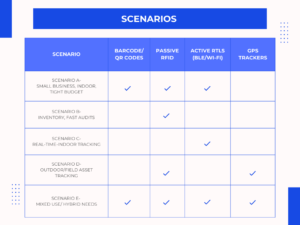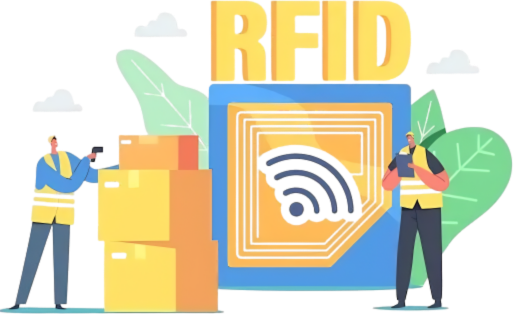Choosing between different asset tracking technologies such as barcode, RFID, GPS, and newer IoT options can feel overwhelming. The best choice depends on your business’s needs and environment. We’ve also covered on Asset Tracking broadly in a separate blog – “Asset Tracking: The Ultimate Guide for Finance, IT, and Operations”, which complements the technology selection framework presented here.
In this guide, we present a 5-step framework to help IT managers and operations teams make the right choice. We’ll compare today’s top asset tracking technologies, outline key selection criteria, provide a decision matrix for different scenarios, and share real-world examples. Let’s dive in!
Step 1: Overview of Today’s Top Asset Tracking Technologies
What asset tracking technologies are available? Each technology has unique strengths and ideal uses. Here’s an overview of the leading options:
- Barcode Asset Tracking (QR Codes): Uses printed labels that are scanned by a mobile phone scanner. It’s low-cost and simple, but requires line-of-sight scanning and manual effort. Ideal for automation of Asset Inventory.
- RFID Asset Tracking: Uses radio-frequency identification tags (passive or active) that transmit ID data via radio waves. It allows fast, contactless scans of multiple assets at once (no direct line-of-sight needed), making physical audits much quicker than manual barcode scans.
- GPS Asset Tracking: Involves GPS-enabled trackers (usually with cellular or satellite links) attached to assets. Provides real-time location across wide areas – perfect for vehicle fleets, field equipment, and any outdoor asset movement tracking needs.
- BLE Asset Tracking (Bluetooth Low Energy): Uses small battery-powered BLE beacons on assets and receivers (or smartphones) to detect proximity. Commonly used for indoor real-time location tracking (RTLS) in facilities.
- WiFi Asset Tracking: Leverages WiFi-based tags or existing WiFi network signals to locate assets. Useful in WiFi-covered facilities for real-time indoor tracking similar to BLE. It can piggyback on your existing network infrastructure, but WiFi tags may consume more power (needing more frequent charging or battery changes).
Passive vs. Active Tracking: Passive methods (e.g. barcodes, passive RFID) have no onboard power and require an external scanner or reader – good for periodic audits and simple implementations. Active methods (e.g. active RFID, BLE, GPS) have self-powered tags that broadcast signals continuously, enabling real-time tracking at a higher cost. Choose passive if you only need location updates when an item is scanned, or active for continuous visibility into asset location and movement.
Note: All these tagging methods work alongside an asset tracking software platform that records data and provides dashboards. In any solution, the physical tags feed information into software, which you use to view locations, run reports, and integrate with other systems.
Step 2: Key Criteria for Choosing a Technology
How do you choose the right asset tracking technology? The best solution depends on several key factors. When evaluating options, consider these criteria:
- Cost & ROI: Assess both the upfront and ongoing costs, and the potential return on investment. Don’t forget the cost of any readers or infrastructure (barcode scanners, RFID antennas, BLE gateways) and subscription software fees. Calculate whether the time saved or losses prevented will justify the investment at your scale.
- Ease of Implementation & Integration: Gauge how complex each system is to deploy and integrate with your operations. Verify that your chosen asset tracking software supports the technology. Ensure your site has the necessary infrastructure in place.
- Range & Coverage Needs: Match the tech to the physical range over which you need to track assets. Also consider coverage density: an RFID reader typically covers a room-sized area (roughly up to 30 ft for passive RFID tags), an individual BLE beacon covers ~30–100 ft, and WiFi or ultra-wideband (UWB) systems can cover larger areas with multiple access points. Think about location accuracy requirements too.
- Real-Time Tracking Requirements: Decide if you need continuous real-time location updates or if periodic/manual updates are enough. Real-time asset movement tracking is necessary if you require live visibility of assets moving around (e.g. forklifts in a warehouse, wheelchairs in a hospital). In that case, an active RTLS solution (BLE, WiFi, or active RFID) will broadcast constant signals so you can see an item’s location at any moment. In contrast, passive systems only update when an item is scanned or checked in, which may be fine for static assets or those that move infrequently.
- Maintenance & Operational Constraints: Consider the ongoing maintenance and workflow impact of each tracking technology. Power or battery life is a key factor. For example, active tags have batteries that need charging or replacement. In contrast, passive tags and barcodes require no power source. Additionally, tag durability matters—what conditions will the tags face? For instance, industrial environments may need rugged tags or labels that resist water, heat, or chemicals.
By carefully evaluating these criteria – cost, implementation, range, real-time needs, and maintenance – you can narrow down which asset tracking technology (or mix of technologies) aligns best with your budget, environment, and operational requirements.
Step 3: Decision Matrix – Matching Tech to Business Needs
Now, let’s map common business scenarios to the best-suited asset tracking technology. Use this decision matrix as a quick guide to identify the optimal solution based on your context:
- Scenario A – Small Business, Indoor, Tight Budget: Use Barcode/QR Codes. For a small office or IT department with a limited number of assets and only periodic tracking needs, barcodes or QR code labels are the most cost-effective and simple choice. Why: Labels cost next to nothing and require no special hardware beyond a smartphone or handheld scanner.
- Scenario B – Large Inventory, Fast Audits : Use Passive RFID. For a large office or manufacturing facility managing thousands of assets, passive UHF RFID is ideal to speed up asset inverntory. Why: RFID allows bulk scanning – a single reader can detect dozens of tags in seconds, even without direct line-of-sight.
- Scenario C – Real-Time Indoor Tracking (Healthcare or Operations): Use an Active RTLS (BLE/WiFi). For environments where critical assets roam within a facility and must be located instantly – for example, medical equipment in a hospital or tools on a large manufacturing floor – deploy a Bluetooth Low Energy or WiFi-based real-time locating system. Why: This provides continuous updates and room-level (or even better) accuracy.
- Scenario D – Outdoor/Field Asset Tracking: Use GPS Trackers. For vehicles, heavy equipment, shipping containers, or any assets that travel over wide outdoor areas, GPS tracking is the go-to solution. Why: Only GPS (often coupled with cellular data) provides reliable real-time location over large distances.
- Scenario E – Mixed Use / Hybrid Needs: Use a Combination Approach. Many organizations find that one size doesn’t fit all when it comes to asset tracking. You might need a mix of technologies to cover different asset types and use cases in the most economical way. Why: A hybrid strategy lets you apply advanced tracking where it delivers the most value, and use simpler methods elsewhere to control costs.

Step 4: Real-World Examples of Asset Tracking in Action
Real-world case studies show how each asset tracking technology delivers value in practice. Here are four examples, each highlighting one of the above approaches:
Example 1: RFID in a large Manufacturing company – Boosting Efficiency – A company previously conducted annual asset inventory at its large factory using barcode scanners, which took several days. To improve efficiency, they implemented a passive RFID asset tracking system and saw immediate benefits. As a result, asset audits that once took a week now finish in just a few hours. Moreover, the new system delivers almost 100% accuracy.
Example 2: BLE RTLS in Healthcare – Preventing Asset Loss – A hospital was struggling with missing equipment and inefficient utilization. Portable devices frequently vanished or were hoarded by departments, leading to over-purchasing “just in case.” They rolled out a Bluetooth-based RTLS, attaching BLE tags to wheelchairs, IV pumps, and monitors throughout the hospital. Result: The hospital’s asset tracking software now displays each item’s live location on floor maps. Equipment hoarding and loss have dropped significantly.
Example 3: GPS Tracking in Logistics – Security & Visibility – A trucking and logistics company faced frequent cargo theft and unauthorized use of vehicles. To combat this, they equipped each truck and trailer with GPS tracking devices tied into their asset tracking software platform. Result: They can now monitor the location of every vehicle in real time, 24/7. Geofence alerts are set up – if a truck deviates from its approved route or a trailer is moved outside the yard after hours, managers get an instant notification.
Example 4: Barcode System in IT Department – Simplicity and Control – An IT department managing 500 employee devices needed a basic tracking method for assignments and audits. Therefore, they chose a barcode-based asset tracking system with a cloud database. As a result, each device was labeled with a unique QR code. During quarterly audits or device issuance, staff scan the QR code using a mobile app. Then, the system automatically updates the asset’s location, custodian, or status in the database. Moreover, this low-cost approach—each tag costs just a few cents—keeps records consistently updated with minimal effort.
Compare solutions with our experts to get a personalized recommendation. We can help evaluate your specific needs and suggest the best mix of technologies for your situation. Compare solutions with our experts to get a personalized recommendation. We can help evaluate your specific needs and suggest the best mix of technologies for your situation.Not sure which asset tracking solution fits your scenario?
Not sure which asset tracking solution fits your scenario?
Step 5: Summary & Next Steps
In summary, choosing the right asset tracking technology comes down to matching the solution to your operational needs and constraints. By following this framework, you can confidently choose an asset tracking solution that fits your needs and your budget, without a costly trial-and-error process. Improved asset visibility will lead to reduced losses, higher utilization of assets, and data-driven insights that improve operations.
Next Steps: Ready to move forward with asset tracking in your organization? Here are a few actionable next steps:
- Conduct a Pilot: Test your chosen technology on a small scale first.
- Get Stakeholder Buy-In: Share your decision matrix evaluation and the expected ROI with key stakeholders (finance, IT, operations leadership).
- Plan the Deployment: First, create a detailed rollout plan. Then, assign responsibilities. For instance, IT sets up hardware and integrations. Meanwhile, managers train their teams.
These steps take you from decision-making to confident implementation of the right asset tracking technology. Now it’s time to turn that choice into improved efficiency and security for your organization. Get a free demo today and start your journey to smarter asset management!



